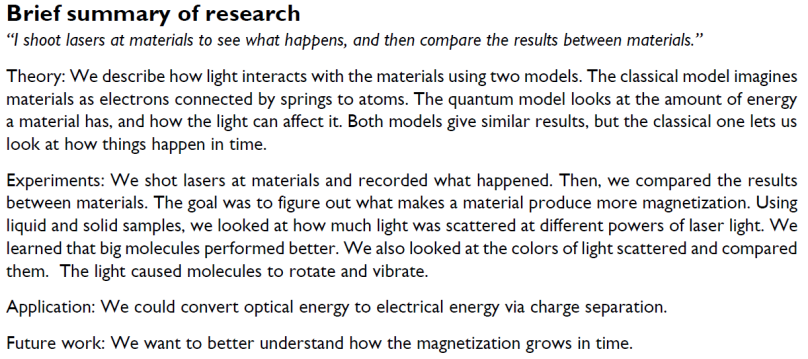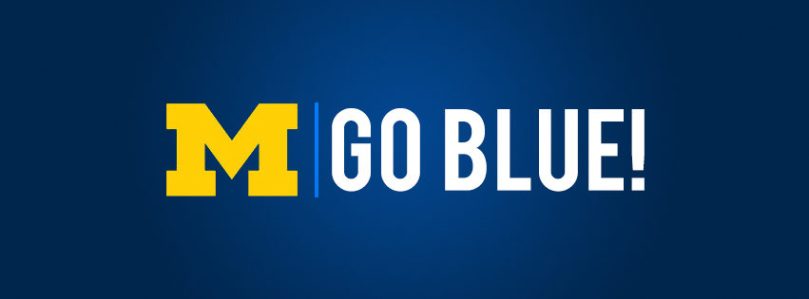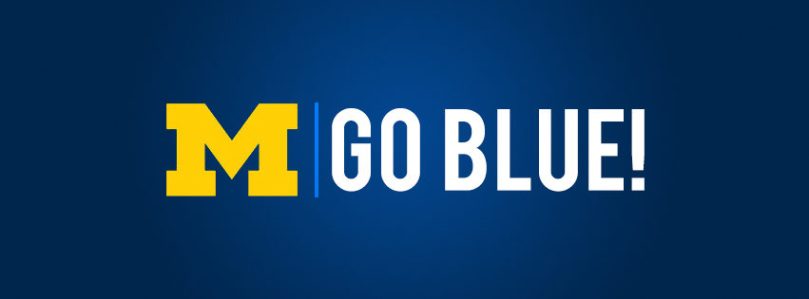Introduction:
Since it has been a full year since I started graduate school, I thought now would be a good time to offer some thoughts and tips on applying for fellowships, specifically the National Science Foundation Graduate Research Fellowship. I have mentored a few undergraduates this past year through the application process and thought that it would be wise to share my tips with all of you. I received the NSF GRFP in May of 2012. If you have questions or comments, feel free to leave them and I will reply when I have the time.
Start early, revise often, and don’t give up!
The Application:
Getting Started:
I had no idea what I wanted to write about. I had never written a research proposal of this magnitude. I was terrified. So, how did I start? I simply broke the problem into a step-by-step process.
- Identified the top 3 professors I was interested in working with
- Found topics from those professors and began to research them in-depth
- Selected my favorite research area from my top-choice professor
- Created a folder of all of the papers the research group had written and did my best to read and understand them
- Identified a niche within the current research being done
- Started writing about that niche
Managing Your Time:
When writing an NSF GRFP proposal, it is important to start early and work steadily on it. You will NOT write a perfect document in a weekend. I started in early September and tried to work on it each week. Find people who can critique your essays and keep you on task. Give yourself deadlines far before the actual deadline. I spent many hours banging my head against my keyboard trying to figure out what to write. Your first draft will not be perfect, but you need a place to start.
Asking for Letters of Recommendation:
Ask early. As soon as you start your application, identify people to write recommendations. I asked my undergraduate research advisor / club advisor, my undergraduate engineering project advisor, and one of my professors. I asked each of them in person and then followed up with an email. Choose people who can give a varied view of you. People who know you as a person and want you to succeed. It is a big time commitment, so choose carefully.
Initial Email Text:
Thank you again for agreeing to recommend me for graduate school research fellowships. I have attached three items to assist you in writing the letters.
The items attached are:
- Academic Transcript
- Extended Resume
- Guidelines for each fellowship
The fellowships that I am applying for are:
- NSF Graduate Research Fellowship Program (GRFP)
--- Due: Novemeber 14, 2011
- DoD Science, Mathematics, and Research for Transformation (SMART)
--- Due: December 1, 2011
- DoD National Defense Science and Engineering Graduate (NDSEG) Fellowship
--- Due: December 16, 2011 @ 5pm
The NSF has the soonest deadline and is the model for the other fellowships. Please use its format as a overall template.
If you need anything else from me at any point in the process, please do not hesitate to ask. I will be also be sharing copies of my essays when the drafts are finished. When I finish deciding which graduate schools I wish to apply to, I will send guidelines for that as well.
Thanks again,
Liz Cloos
In this email, I attached a document detailing each fellowship, what I expected from the writers, and each deadline. You can view it here: Elizabeth Cloos – Reference Guideline – Fall 2011
After asking your writers, it is important to politely remind them every few weeks. An example reminder email is listed below.
Title: Cloos Recommendation Reminders: NSF GRFP -> 11/14, SMART -> 11/30, UMICH -> 12/05
Thanks again for agreeing to recommend me for Graduate school and fellowship opportunities. This is just a friendly email reminder about the upcoming deadlines and submission criteria.
By order of deadlines:
NSF GRFP - Due 11/14 *LETTER SUBMITTED*
- Electronic submission through Fastlane. Should have received an email link.
DOD SMART - Due 11/30
- Electronic submission. Should have received an email link.
- Reference letters must be on official letterhead. Reference letters not on official letterhead may be disqualified from consideration.
UNIVERSITY OF MICHIGAN PHD APPLICATION - Due 12/05
- Electronic submission. Should have recieved an email link.
- Summary: Applying for Electrical Engineering PhD program with a focus on Optics & Photonics
- This one requires the most thought and care.
- Department Link: http://www.eecs.umich.edu/eecs/graduate/ee/eegradpage.html
DOD NDSEG - Due 12/15
- Electronic submission. Should have received an email link.
If you need any help at all or need any more information, please do not hesitate to ask me. I want to make these as easy for you as possible. Re-use from one application to the other should be very easy. Again, thank you very much.
Sincerely,
Liz Cloos
Essay Tips:
Here are tips for each of the individual essays plus some general guidelines on broader impacts and intellectual merit. *** When I applied in 2011, there were 3 essays. These are my tips for those 3 essays. There are now only TWO essays. Read the prompts carefully. ***
Personal Essay:
For this essay, I broke the essay into sections by using italicized headings. I wrote about my extracurricular involvement, leadership skills, why I was in engineering and why I wanted to pursue a PhD. I wanted to show that I had a history of being involved and sharing knowledge and if they would kindly fund my PhD, I would be able to continue to share my knowledge with the world.
Here are the section titles:
How I taught myself Accordion :
Through music, I have discovered myself and the importance of
teamwork, community, and ingenuity.
Leadership on campus:
The study of science is like playing the accordion.
No one really knows what it should do;
They just know that if you push enough buttons something cool will happen.
Why I am an Engineer:
I am enthralled by complexity of light and how it interacts with matter through
interactions such as acousto-optic, magneto-optic, and electro-optic.
Why I want a PhD, specifically from the UM:
I want to create those applications.
I focused on telling a story and making the essay easy to browse. Reviewers have very little time per essay. The easier your essay is to read, the more they will take away from it.
Previous Research Essay:
This essay describes what you have done academically that has prepared you to do thoughtful research. Again, I used section titles, but these were much more formal. Just because you have not done much research in the past does not mean that getting an NSF is impossible. Be open and honest and show through other academic activities that you have what it takes to succeed. SHOW, don’t tell.
“Intro” (not an actual heading): Throughout my years at Michigan Technological University, I have been actively involved in a wide variety of projects. These projects and previous research, leadership, and professional work experiences have prepared me to succeed in a demanding doctoral degree program.
SUMMER UNDERGRADUATE RESEARCH
– Here I described my summer research, what I was trying to do and what I learned. Although my project yielded no actual results, I explained how the “intellectual merit” of the project was that I learned about the research process.
ENTERPRISE: ENGINEERING PROJECT EXPERIENCE
– Here I detailed three engineering projects I worked on as an undergrad. This was senior design or capstone level work. Since I had only done research for a summer, I spent the majority of my essay describing this. For each project I explained the “broader impacts”.
Ex. The broader impacts will be a mobile solar system and water filter that can provide remote locations with clean drinking water despite lack of electricity.
PREPARATIONS FOR PROPOSED RESEARCH
– I finished the essay with a description of my senior level coursework and how I was choosing to take hard electives to better prepare me for grad school as opposed to easy electives.
Future Research Essay:
This was the hardest of the essays for me to write. I had no clear idea when I started, but now am very happy with what I ended up with. Again, I split the essay into easy to understand sections with headers.
MOTIVATION
– This answers the question: “Why is researching this topic worth while? What is the big deal?”
HYPOTHESIS
– What do you believe will find by doing research and experimentation?
BACKGROUND
– What has been done by other people, what have you done to prepare for this topic
RESEARCH PLAN
– I broke this up into three sections with the format of below
Year I – Education
Specific Aim I:
Methods I:
Year I focused on education and learning what I needed to know to do thoughtful research since I had not done much in this area before. Year II described the actual experimentation that I wished to do. This was the meat of the essay. Year III detailed the analysis and further experimentation.
ANTICIPATED RESULTS
– What did I expect to see?
INTELLECTUAL MERIT
– What is academically important by the research? Why would it matter to the world?
BROADER IMPACTS
– Where will I present this research? How will other people benefit from this?
REFERENCES
– I used the format of:
S. C. Rand, W. M. Fisher, and S. L. Oliveira, “Optically-induced magnetization in homogeneous, undoped dielectric media,” J. Opt. Soc. Am. B 25, 1106-1117 (2008).
Broader Impacts and Intellectual Merit:
Every time that I mentioned the words “Broader impacts” or “Intellectual Merit”, I bolded them. It makes it easier for a reader to skim and find what he or she is looking for. It adds emphasis to the right areas. In the proposed research, I gave them special sections.
General Comments:
- Again, FORMAT matters. Make your essay as easy to read as possible. Bold what needs emphasis, and CAPS headings if needed. But, don’t overdo it. Keep the document looking clean and neat and tidy.
- Write a common story. Each essay should complement each other. Do not duplicate all information, but make sure that the essays reinforce one another. The reviewers should come away with a clean and complete picture of you and your proposed research
I submitted these tips to the NSFGRFP website:
• What are your top three suggestions for applicants when preparing their application (essays, addressing the merit review criteria, etc.)?
- Do not underestimate the power of formatting. Make it as easy as possible for the reviewers to find the merit review criteria in the essays. Bold “Broader Impacts” and “Intellectual Merit” whenever you talk about them and use Headings to clarify your thoughts.
- Proposed Research — Keep it simple. Be specific. It’s okay if you don’t know much about what you want to do. If you don’t know, tell them about what you are going to do to learn more about the problems you wish to solve.
- Previous Research — If you don’t have any previous research, try to think about what else could count. I wrote about all of my engineering capstone experience. Also, explain what specifically what YOU contributed to these projects.
- Personal Essay — Write about something that makes you unique and shows that you have a history of sharing science. Think outreach and education.
• What are your top three suggestions for applicants regarding reference letters (e.g., who to ask, what information to provide references, how to ask for references, etc)?
- Ask early. Give references at least 2 months notice and remind them every few weeks. Set a deadline for them that is earlier than the NSF GRFP deadline.
- Provide your references with a detailed list of everything you have been involved in in college (Internships, Jobs, Research, Extracurricular), your accomplishments (Scholarships, GPA), and your goals for Grad School. Then, tell each person to focus on a unique aspect of that list. This ensures a diverse set of letters that paint a larger picture of who you are.
- Ask for references in person. Then, follow-up with an email with the details such as the deadline, what you need them to write about, and all other supporting documents.
• What are your top three suggestions for reference writers (such as the type of content to include)?
- Ask your applicant what they want you to include in the letter.
- Be enthusiastic.
- Show, don’t tell. Paint the picture of who the applicant is.
• Other advice we should include?
- Start early. It may feel like you are banging your head against the keyboard, but the sooner you start the better.
- Have as many people read your essays as possible.
- Seek out proposal writing resources at your university.
Other Resources:
Other Fellowships:
There are many other options for applying to fellowships. It depends on you major and area of research interest. I also applied for:
Check out the fellowship resources at your own or proposed university. Here are a list of some provided by the EECS department at Michigan.
Disclaimer: This is what worked for me. I do not guarantee it will work for you. This is just a guide in case you are stuck and need some inspiration.











